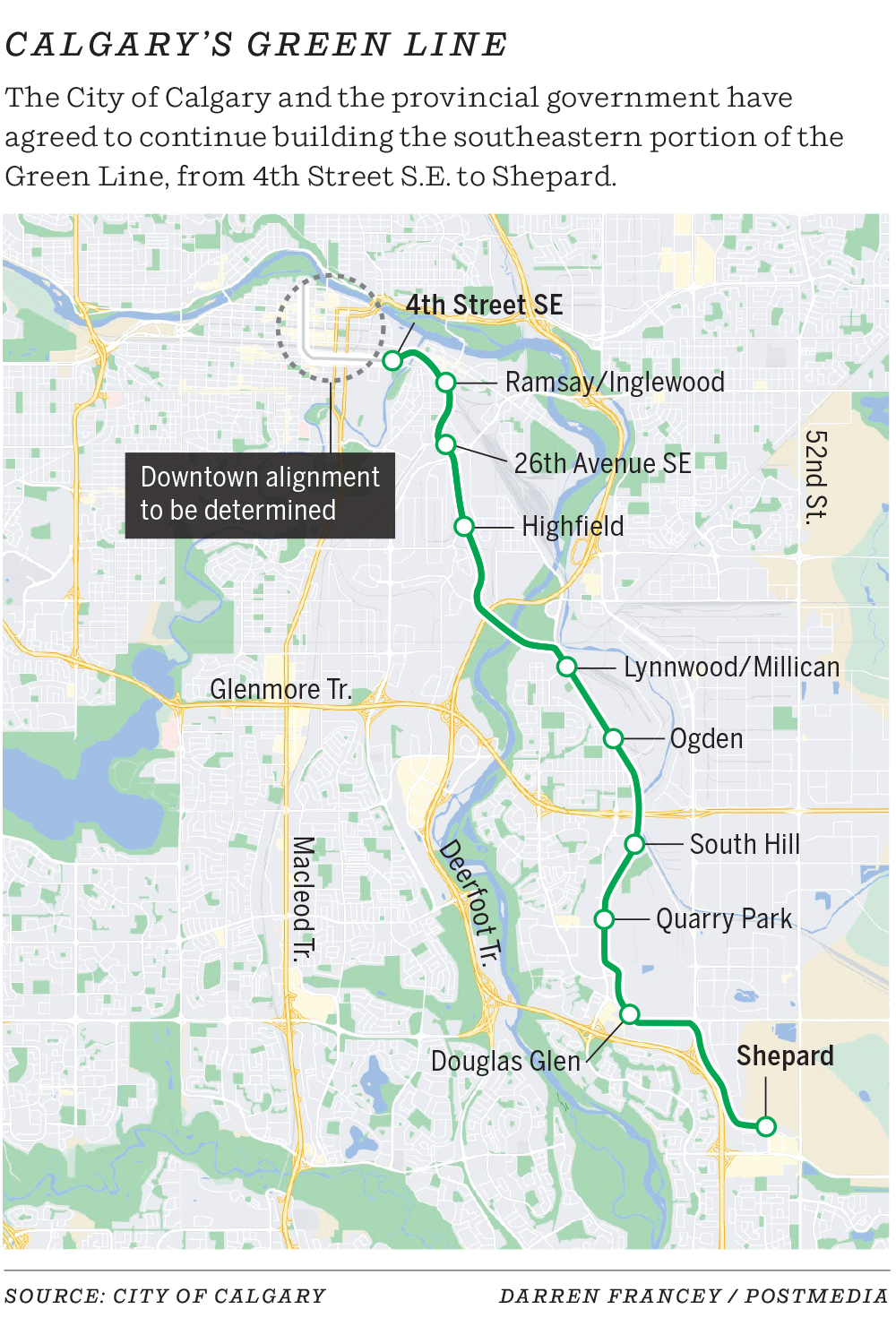Questions remain as to how the Green Line might pass through downtown, while the province looks at either above ground or elevated options.

A provincial study into an alternate Green Line alignment for downtown Calgary has led some organizations to hope they will be heard during planning discussions.
Following over a month of political back and forth, last week provincial transportation minister Devin Dreeshen and Calgary mayor Jyoti Gondek issued a joint statement, noting that the city and province have agreed to retain several Green Line contracts.
Questions remain as to how the Green Line might pass through downtown, and the costs associated with tunneling have led the province to deem it unreasonable.
Stakeholders ‘not forming opinion’ yet
With just street level or elevated alignment options — where will the trains go? That’s among some of the questions the Calgary Downtown Association (CDA), along with commercial real estate groups NAIOP and Boma Calgary hope to help answer.
In a joint letter, to premier Danielle Smith, minister Dreeshen, and mayor Gondek, the trio requested “a commercial real estate industry advisory committee” be formed.
The letter notes that all three organizations’ members are “heavily vested into and support the Green Line transit corridor”.
“Whatever recommendations may be proposed by AECOM or others, the Green Line, whether built or not, will have an enormous and direct material impact on our members,” the letter read.
“We want to be in the room to help participate and build a fantastic product for Calgary,” said CDA executive director Mark Garner in a Sunday interview with Postmedia.
Without sitting down with AECOM, the province and the city he says they’re not forming an opinion between elevated or street level until they know what is being considered.
“We could speculate all we want and come up with responses for god knows what is being developed, that’s why we want to be in the room,” Garner said.
Green Line ‘critical’ for Calgary
NAIOP, BOMA and CDA members own and operate billions of dollars of real estate investment in the city.
“We contend that the Green Line should provide connectivity, not impair property values, and be built to sustain the city’s future needs,” read part of the joint letter.
Garner says that redesign opportunities, like the Green Line, make downtown an even “better place to live, work, play, learn and shop,” particularly when parties stay focused and work together.
“The province is doing good work, and I think the municipality is doing good work, and we just want to be there at the table with their specialist as they determine ‘hey, we want to look at this street’,” Garner explained.
The letter recognized the importance of bringing the long-studied Green Line to fruition, calling it “an essential public service and critical to Calgary’s mobility system and growth.”
Data from the trio of organizations needs to be looked at as part of the conversation, Garner said. This includes “employment clusters” moving between different buildings, of which Garner gave an example:
“(Say) there’s a large tenant that’s moving up to the Petro Canada building, we know that stuff and we can bring that to the table.”
He says they also know what’s currently being developed in downtown, what their plans are, and what tenants they’re trying to “recruit” downtown.
“You’d hate to recruit a large tenant to downtown and then all of a sudden find out, oh, the Green Line’s going there . . . It’s going to be under construction for three years,” said Garner.
Those things can help facilitate and ultimately build a great design he said, also mentioning some of their expertise could help determine which areas might be better suited for elevated track or at-grade.

City and province found ‘meeting of the minds’: Smith
The cost for every one kilometre underground is $1 billion, while elevated is $300 million and at grade is $100 million, said Smith, based on what AECOM had told her.
Speaking about where the city and the province have discussed agreement during her Saturday radio show, the premier said, “We agree that everything to the event centre and a new union station south, the engineering has been done so let’s work on that,”
“Then let’s wait for AECOM to get back to us in December to see if they can find an above-ground alignment that satisfies all of our concerns.”
Smith said she’s happy with the way things are going.
“I think we’ve found a meeting of the minds and I think people should be confident that we’re going to get a line that actually works, that actually goes somewhere.”

Last week, Gondek told reporters the city has been working closely with the province “looking at whether there was anything in the original Green Line project that could be acceptable to them, given their desire for a new alignment.”
“Good news for about 700 people who will be keeping their jobs and work will progress to the south,” she said at the time.
— With files from Scott Strasser, Matt Scace and Bill Kaufmann
